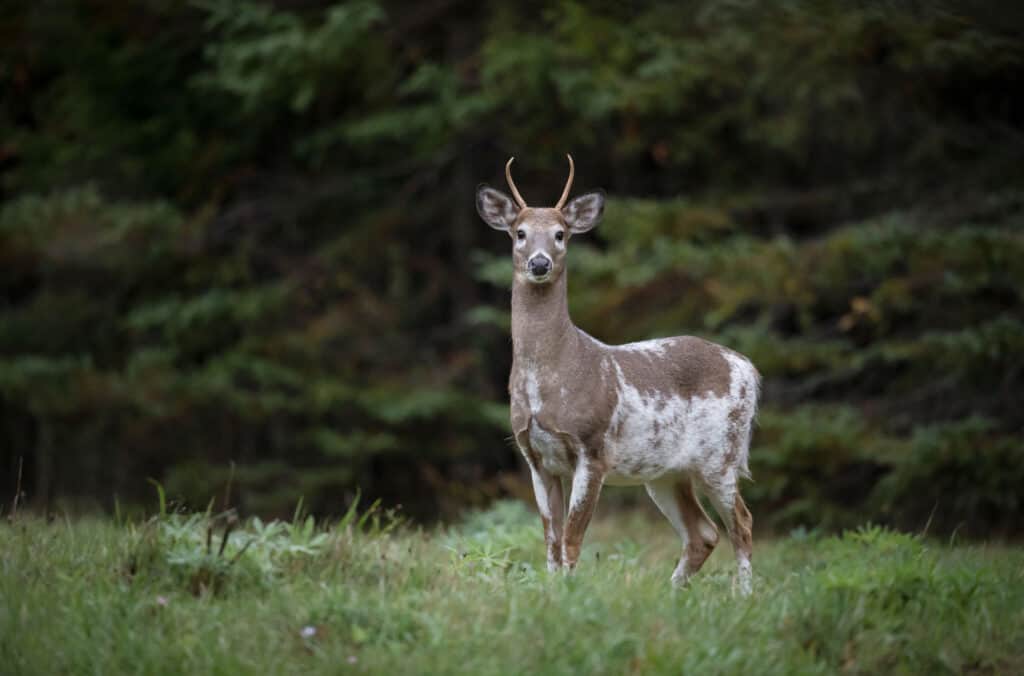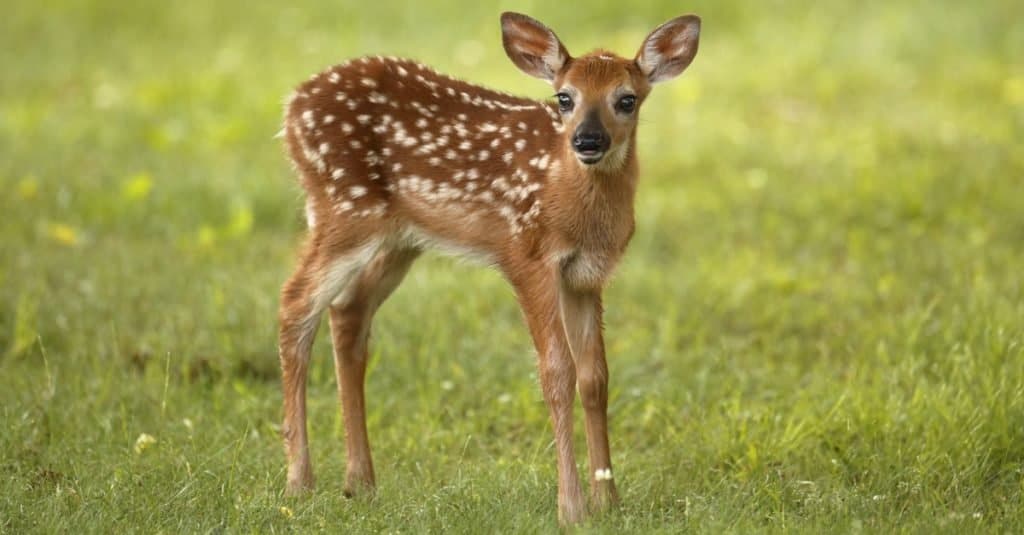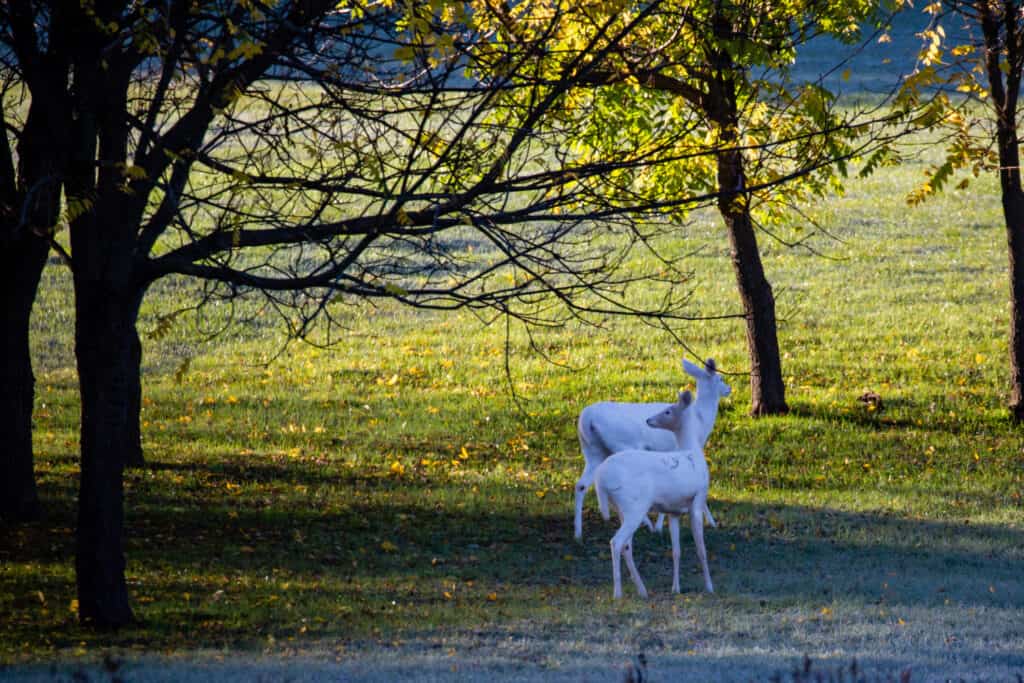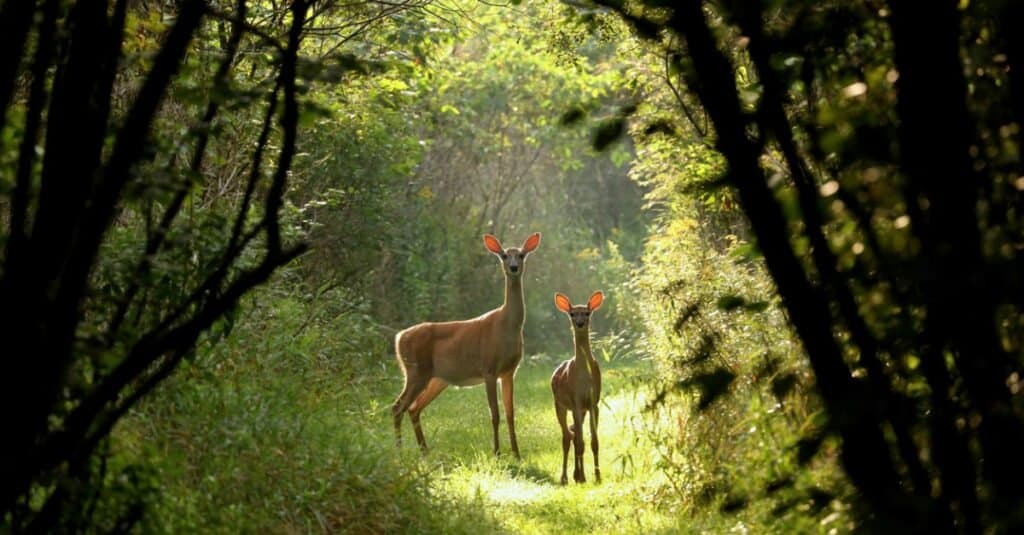Deer season is open in Minnesota in the fall and early winter, from mid-September until the end of the year. The state is divided into three basic zones, with various sub-zones. Statewide the dates for the Archery and Muzzleloader deer seasons follow the same dates, with the Firearms season starting in early November for all zones but open for two weeks in zone 100 versus only one week in other zones.
There is also a Firearms season that is open for one week in certain zones in late November. One weekend is set aside statewide in late October for youth hunters and antlerless deer only for adults. In December, a weekend was just added in 2022 for the CWD zones.
Below we will discuss the various seasons, licenses, and rules for deer hunting in Minnesota. All hunters, even experienced ones, should review the current Minnesota Department of Natural Resources hunting guide for zone maps, licenses, permits, and regulations for deer hunting. These can change each year and may differ from what you are familiar with in previous years or other states.
Hunting License Requirements

To deer hunt, a license must be purchased for the hunting method that you would like to use, Archery, Muzzleloader, or Firearm.
©iStock.com/Brittany Crossman
Anyone that would like to deer hunt in Minnesota is required to obtain a license. To deer hunt, a license must be purchased for the hunting method that you would like to use, Archery, Muzzleloader, or Firearm. Licenses are available for both residents of Minnesota and non-residents. If you are a non-resident and would like to visit Minnesota to hunt, you must have a valid Minnesota non-resident license. A license from your home state will not be valid.
Licenses can be purchased online here, by phone by calling 1-MN-LICENSE, or at approved vendors throughout the state. A list of vendors can be found here. Hunters may not purchase more than one archery, muzzleloader, or firearms license per year. The license comes in a two-part form, with the upper half being a tag used to tag the harvested deer in the field.
If you purchased your license online, the license would be mailed to you, and you must have received it and have it with you to hunt. Licenses can be purchased beginning on August 1st, so plan.
The type of license required also depends on the hunter’s age. Youth hunters ages 10 to 12 can obtain a free license for the three hunting methods. Youth hunters ages 13 to 17 can obtain a discounted license (currently $5) for each of the three hunting methods. Adults ages 18 and older should purchase a regular license for their chosen method.
In addition to the hunting method, licenses are purchased for a particular zone. Hunters can change the zone of their license for $5 after purchasing the license if needed. Lifetime licenses for deer hunting are also available. The cost depends on the hunter’s age, with the lowest cost for children three years old and younger or adults 51 years old and older.
Hunters can purchase and hold all three archery, muzzleloader, and firearms licenses. Bag limits may be different for the zones, so all three tags may not be able to be filled if they are all for the same zone. The hunter should understand the limits for the number and type of deer for each zone they hunt in and have a license. The statewide bag limit is five deer for the entire season. Any deer harvested during the early antlerless season and the late CWD season does not count towards this limit.
The statewide limit for antlered bucks is one, except in certain zones. The early Antlerless season does not require a special permit as it did before 2022. The bag limit for this season is now three antlerless deer, which is in addition to the statewide bag limit. Some zones hold a lottery for the early antlerless season, and the application deadline is typically early September.
Bonus permits and Disease management permits are available for hunters to take additional antlerless deer in certain zones up to the zone limit. Hunters must have a regular archery, muzzleloader, or firearm license for their hunting area. The bonus permits may not be used in bucks-only, antlerless permit lottery, or either-sex designated zones. The disease management permits may only be used in the 600 series zones.
Landowner deer licenses are free and allow hunters to take on additional antlerless deer in certain zones. This license is available only to the owners or tenants of land at least 80 acres and is owned or leased for agricultural purposes. Only one of these licenses may be purchased yearly, and the license holder may give the license to a spouse or a dependent.
Landowners who obtain this license must not post their land for no hunting, but the public must still obtain permission, and the landowner can regulate how many hunters hunt on their land.
Hunters that were born after December 31st, 1979, must have a firearms hunter safety certificate showing that they completed a hunter safety course to purchase a license to hunt with a firearm. Youth hunters 11 years old and younger are not required to have taken the course. The class is available online and in person; more info can be found here. If you want to try hunting and still need to complete a hunter safety course, an apprentice hunter license is available.
This license allows you to hunt without the safety certificate for a limited time. The apprentice hunter must purchase all of the normally required licenses plus this license, and it can only be purchased in two license years in a lifetime. When the apprentice hunter goes hunting, an adult with a valid license to hunt deer in the same season must accompany them. The hunter must always remain within sight and hearing distance of the accompanying adult.
Deer Season Types

Any
deer harvested during the early antlerless season
and the late CWD season does not count towards this limit.
©Paul Tessier/Shutterstock.com
In Minnesota, there are three types of deer seasons: Archery, Muzzleloader, and Firearm. Archery season is the longest and opens on the third Saturday in September until the last day of the year. Firearms season opens on the first Saturday in November and lasts for one or two weeks, depending on the zone.
Muzzleloader season opens on the Saturday after Thanksgiving and is open for two weeks. In addition to these three basic seasons, there are a few other special seasons for certain age groups or permit holders. The third week in October, Thursday-Sunday, is the youth hunt and the early antlerless season. The late CWD hunt is the third weekend in December.
There are also special hunts that are held in Wildlife Management areas that are limited to hunters with special permits that can be applied for and are selected by a lottery. The dates, methods, and bag limit vary depending on the area.
Season Type Regulations
Hunters must use approved hunting methods and devices while hunting in the season that is open and/or that they have a license. Listed below are some of the requirements for each season:
Archery Season
Hunters with an archery license hunt during the archery season may hunt with a bow and arrow. Bows must have a draw weight of more than 30 pounds at or before the full draw. Arrows must have barbless broadheads that have at least two metal cutting edges and are at least 7/8 of an inch in diameter.
Expandable broadheads may be used if they are barbless and at least 7/8 of an inch and no more than two inches in width after impact. A mechanical release attached to the drawstring may be used as long as the hunter draws and holds the string without any mechanical aid. No type of firearm may be used during archery season.
Crossbows may be used in certain cases during archery season. Hunters that have a special permit because of a disability or hunters that are 60 years of age and older may hunt with a crossbow during archery season. Otherwise, they are only allowed during the firearms season.
Crossbows must be shoulder-fired, deliver at least 42 foot-pounds of energy at 10 feet, have a working safety, and use bolts or arrows at least ten inches long.
Muzzleloader Season
Hunters that have a muzzleloader license to hunt during the muzzleloader season may hunt with a muzzleloading rifle, shotgun, or handgun. Muzzleloaders, by definition, must be loaded from the barrel’s muzzle and not allow firing components (projectile and powder) to be loaded from the breech.
Rifled Muzzleloaders must be at least .40 caliber. Smooth-bore muzzleloaders must be at least .45 caliber and fire a single projectile. Muzzleloaders can have optical scopes. Other types of firearms that fire cartridges are not allowed during this season.
Firearm Season
Hunters with a firearm license to hunt during the firearm season may hunt with a centerfire rifle, shotgun, or handgun. Crossbows may also be used during this season. Rifles and handguns must be at least .22 caliber and fire a single projectile that has a soft point or an expanding type bullet.
Shotguns may only fire a single slug. Buckshot is not allowed. Hunters should select bullets of the proper design and weight to take deer. In certain areas, non-toxic ammunition must be used. Bullets and slugs must be made entirely of non-toxic material approved by the US Fish and Wildlife Service.
Youth Season
This 4-day season is set aside for youth hunters only ages 10 to 17. Youths ages 10 to 13 must be accompanied by adults 18 or older. The adult does not have to be licensed and cannot hunt. Youth hunters may take one deer during the youth season statewide. Antlerless deer may be taken except in areas that buck only. Crossbows may be used by a youth that has a youth firearm license.
Regulations To Consider

Hunters should select bullets of the proper design and weight to take deer.
©iStock.com/Michael-Tatman
There are several key rules to keep in mind before you go on your first deer hunt in Minnesota. Below is a partial list of some of the most notable ones. This list is not extensive. Everyone should read and understand all of the rules that may apply to you before hunting.
- Hunters may not enter private land that is legally posted or used for agriculture without permission from the landowner.
- Hunters may not discharge a firearm within 500 feet of an occupied building, livestock barn, or area less than one acre where livestock is contained without permission from the landowner.
- A person may not transport a firearm in a vehicle unless it is unloaded and inside a case so that no part of the firearm is exposed.
- Deer cannot be taken while a person is inside or in a motor vehicle, except for hunters with a disability permit.
- During the regular firearms season, the use of all-terrain vehicles and snowmobiles is restricted to before legal shooting hours (1/2 hour before sunrise), from 11 am to 2 pm, and after legal shooting hours (1/2 hour after sunset) on public property. On private property, the hunter should have the landowner’s permission first.
- Dogs are not allowed to be used to pursue or assist with hunting deer. An officer may kill any dog that endangers deer at any time of the year.
- Dogs may be used to retrieve a wounded deer however must be leashed.
- A hunter cannot use artificial light to find or locate deer.
- Night vision or thermal imaging equipment is not allowed to be used or possessed by anyone while possessing a firearm, bow, or other implements used for hunting.
- Radio-controlled drones cannot be used to locate or assist with taking deer.
- Using radios, cell phones, walkie-talkies, or other radio equipment to take deer is not allowed.
- Everyone in the field during open firearms or muzzleloader season must wear blaze orange or pink on the upper part of their body, including the head. Blaze orange and pick camouflage patterns are allowed; however, they must be at least 50% orange or pink within each square foot.
- Discharging a firearm or an arrow from a bow from a public roadway or the right-of-way is not allowed.
- Antlered deer are defined as deer that have one antler that is at least 3 inches long.
- Hunting deer with the aid of bait is not allowed. Bait can include grain, vegetables, fruit, hay, nuts, or any other food that attracts deer. Bait must be removed from a site at least ten days before hunting over it.
Safety Information
Safety should be a priority for everyone while hunting. Be sure to understand and follow the four basic rules of firearm safety. Treat every firearm as if it were loaded. Always keep the muzzle of a firearm pointed in a safe direction. Keep your finger off of the trigger until you are ready to shoot. Be sure of your target and what is beyond it.
Depending on the zone or permit you are hunting with, it is important to know if your target deer is antlered or antlerless. Make sure you can identify your target deer clearly before taking a shot.
Also, ensure what is beyond your target deer in case you miss your shot. If you miss your target deer, is there another one you may hit instead? You could inadvertently take the wrong deer and possibly violate your bag limit. Also, ensure there are no buildings or areas where people or other hunters may be beyond your target deer. Don’t forget that you are responsible for every arrow or bullet you shoot.
If you use a tree stand or other elevated position to hunt, being safe is also important. A common belief is that most hunting accidents come from firearm injuries, while most accidents are fall injuries that occur while hunters climb into or out of a tree stand. If you use a tree stand, understand how to use it properly.
Inspect it regularly and replace or tighten any missing or loose parts. Use a safety harness and connect to a safety line before your feet leave the ground.
Never try to climb while carrying a firearm, bow, or any other gear. Connect a line to your equipment and pull it up after you are safely in your stand. Ensure any firearms are unloaded and the muzzle is pointed away from you while pulling it up.
Chronic Wasting Disease Concerns in Minnesota
Chronic Wasting Disease (CWD) affects elk, deer, moose, and caribou. CWD was first detected in deer in elk farms in Minnesota in 2002 and in wild deer since 2010. CWD is a fatal disease. An infected deer can have a drooping head and ears, bad coordination, a thin body, excessive salivation, thirst, and urination. The disease can grow inside an infected deer for 1 ½ to 3 years before they show any symptoms.
During this time, the infected deer can spread the disease. The Minnesota DNR uses CWD zones to test and contain the disease where it has been found. Carcass transportation restrictions have also been put in place to slow the spread. For more info on CWD, see here.
If a deer is harvested inside a CWD management, control, or surveillance zone, hunters must provide a sample from deer older than one year. This must be done within 24 hours during the opening weekend of the firearms season. Samples can be collected at either staffed or self-service stations. Deer must be registered before sampling.
At self-service stations, it is recommended that hunters remove the head of the deer before coming to the station. If you want to keep the antlers, they must be removed before bringing the head to the station, as the head will not be returned. If you have a trophy deer, a partnering taxidermist can provide the needed samples. Test results are provided online sometime after the samples are received. Hunters should keep the meat separate from other meat until the test results are received.
Deer harvested inside the CWD zones cannot be transported outside the zone to other areas of the state until a “not detected” test result is received. Most states do not allow deer carcasses from other states to be transported into their state, regardless of testing. If you are a non-resident of the state and wish to transport your deer back to your home state, be sure to have it processed in Minnesota first.
Tagging and Transporting

Most states do not allow deer carcasses from other states to be transported into their state, regardless of testing.
©iStock.com/Karel Bock
After harvesting a deer and before moving it, you must detach the tag from your license and immediately notch the tag with the month, day, and time of day the deer was taken. Be sure to notch the correct information. If two months or days are notched, the tag becomes invalid.
You can then field dress the deer and drag or carry it to a location to be transported. When the deer is placed into a motor vehicle or ATV, you must attach the tag to the deer. It can be attached to the base of an antler, through a slit cut in either ear, or between the tendon and bone of a hind leg with string, wire, or a zip tie. The tag must remain with the deer until it is processed for storage.
All deer that are harvested must be registered within 48 hours. The antlers must remain attached to the deer, which cannot be processed until registration is complete. Deer may be transported out of the area before they are registered, except in the CWD control zone, where carcass movement is restricted.
There are three available options to register deer: Walk-in stations, by phone, or online. For the walk-in station, transport your deer to one of the stations. Make sure your tag is attached to your deer before transporting it. For the phone option, call 888-706-6367 and answer the series of questions. Once complete, write the confirmation number on your tag in the appropriate area. For the online option, go to www.mndnr.gov/hunting and similarly answer the list of questions about your deer. After completing the questions, record the confirmation number on your deer tag.
The confirmation number is your proof that the deer has been registered. If you process your deer, do not dispose of the carcass on public land or in water. You can dispose of it on private land with the landowner’s permission, at a local landfill, or through a waste management company.
Fines and Jail Time
Harvesting a deer illegally in Minnesota can result in fines, loss of hunting privileges, and even jail time. Trespassing is also a common occurrence. There can be civil or criminal charges if convicted, with fines up to $3,000 and license revocation.
Anyone that violates a Fish and Game law can face a fine from $100 to $3000 and jail time from 90 days to one year. If you take a deer illegally, you can also face restitution fees. This doesn’t count any court costs or lawyer fees if your case goes to court.
Before going on your first hunt in Minnesota, even if you are a veteran hunter in another state, read and understand the rules and regulations for deer hunting. If you assume and make a simple mistake because you didn’t know, it could turn into a big problem.
Up Next
The photo featured at the top of this post is © iStock.com/Louise Wightman
Sources
- Michigan State University College of Law, Available here: https://www.animallaw.info/statute/mn-fish-game-chapter-97a-game-and-fish-penalties#s345
- Minnesota Department of Natural Resources, Available here: https://files.dnr.state.mn.us/rlp/regulations/hunting/full_regs.pdf
- Minnesota Department of Natural Resources, Available here: https://www.dnr.state.mn.us/hunting/deer/index.html
Thank you for reading! Have some feedback for us? Contact the AZ Animals editorial team.






